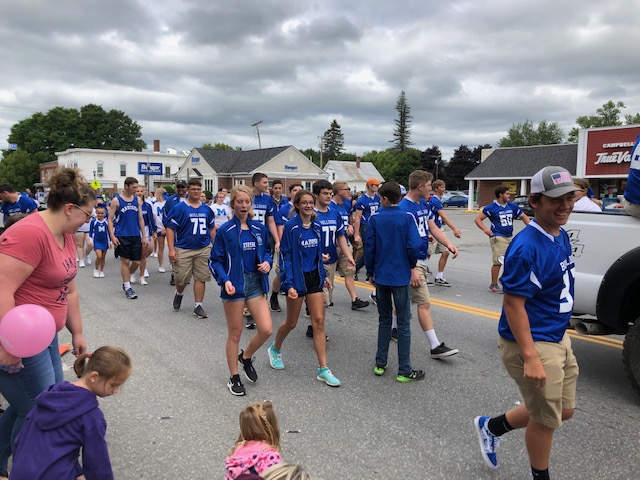MADISON — Jim Libby approached the open door at the historic Weston Homestead House, reminiscing about working for Evie Weston there nearly 60 years ago.
“I mowed the lawn, helped cultivate the garden,” Libby, now 72, said of the former working farm. “Back then, she paid us $1 an hour and she fed us. They had hired hands that stayed here. They cut wood and worked the farm. We used to pick up oil nuts in a basket and she put them upstairs in the attic to dry and she cracked them and used them for muffins and cakes.”
Libby and his wife, Judy, of Skowhegan, had come to the open house at the old farm along the Kennebec River Saturday as part of the annual Madison-Anson Days, a four-day celebration that also included a parade, children’s activities, charity dynamite cook off, library book sale, carnival, guided boat tours on the river, lobster bake and chicken barbecue.
At the Weston farm, built in 1817 and located at the end of Weston Avenue, a dead-end road, the wind blew cool off the river as people trickled into the house to take a trip back in time.
Inside, owner Stephen Burns and Madison Historical Society treasurer Lena Arno welcomed guests and answered questions about the three-story, 12-room house with eight fireplaces and memories galore as documented in the book, “Life on Grandpa’s Farm,” written by Alice Weston Todd and copyrighted in 1954.
Burns was feeding blueberries to an abandoned baby bird in the farm’s kitchen, which featured a large, open fireplace. Burns, of New Hampshire, bought the house three or four years ago after hearing about it from a friend who had moved to Norridgewock, he said.
“My plan is to simply preserve it and pass it on to someone of like-mind,” he said.
The house has several bedrooms, sitting rooms, a dining room and pantry, all furnished with items from the 1800s.
Earlier in the day, hundreds of people lined the streets downtown to watch the annual parade, which featured horses, fire trucks, sheriff’s vehicles, Kora Shriners, tractors, antique cars, floats and Madison and Anson football players and cheerleaders.
“You’ll see a good Renys float here in a little bit,” said Reny’s department store manager Dean Olmsted. “We’re celebrating 70 years.”
Olmsted was standing on the sidewalk outside the store, where sidewalk sales were popular during Madison-Anson Days, he said.
“We get a lot of traffic,” he said. “We do a lot of markdowns. I did it all week, Monday through Sunday.”
Olmsted snapped a photo of the store’s float, flanked with colorful balloons, as it passed. The float received a third-place trophy. Reny’s took part in Thursday’s dynamite cook off, which was to benefit Special Olympics.
“We had to survive a thunder shower and a heavy rain,” Olmsted said. “Backyard Farms did a lot — donated all the cash prizes. They gave away tomatoes.”
The lengthy parade started at Garret Schenck School in Anson, crossed the bridge into Madison and continued through the downtown. Children flocked to the roadside as parade participants tossed them Tootsie Rolls and other candy. Rebel Rose, a new store downtown, handed out fresh roses.
Fred and Diana Giampietro, of East Sandwich, Massachusetts, on Cape Cod, sat on the steps of Buzzy’s Barber Shop with the their 3-year-old chocolate lab, Zack.
The couple said they were visiting friends in the area and were enjoying the parade.
“We were commenting that we’ve never seen tractors in a parade in Sandwich,” Diana Giampietro said. “I grew up on a farm, so it’s a joy to see.”
A cool breeze wafted down Main Street as kids sold lemonade on the sidewalk to benefit the local animal shelter. Mothers and fathers carrying babies strolled down the street as other children tore around on bikes and scooters.
The day was to end with a fireworks display starting at 9 p.m. from the Anson side of the Kennebec River.
Madison-Anson Days, formerly known as Father Rasle Days, marks the Aug. 24, 1724, massacre by British soldiers of French Jesuit priest Sebastian Rasle and 80 of his Abenaki Indian followers in what is now Madison. The attack happened in the Indian village at Old Point, on the Kennebec River, where a monument to the priest and his mission is located.
The massacre, as told by Maine author Mary Calvert in the book “Black Robe on the Kennebec,” occurred during the fourth of the early Indian wars that led to the French and Indian War of 1754-1763.
To the French, Rasle was a saintly missionary. To the English, he was a ruthless revolutionary bent on seizing land for his native country, according to Calvert.
“The Kennebec ran red with the blood of the proud Norridgewocks that day,” her book says.
The Norridgewocks were a band of Abenaki Indians to whom Rasle had ministered for 30 years. Also slain that day, according to Calvert’s history of the region, were two Abenaki tribal leaders, Bombazeen, an orator and warrior, and Moog Megone, a “sachem” or great chief who was immortalized by John Greenleaf Whittier’s poem “Moog Megone.”
Sunday’s activities will include a 5K Glory Run/Walk at 8 a.m. at Madison Junior High School; smallmouth bass fishing derby from 8 a.m. to 2 p.m. at the Nathan Street boat landing; and a golf tournament from 1 to 5 p.m. at Lakewood.
Send questions/comments to the editors.




Comments are no longer available on this story